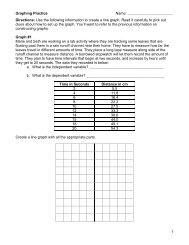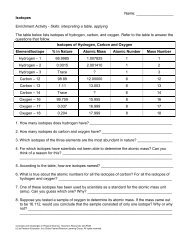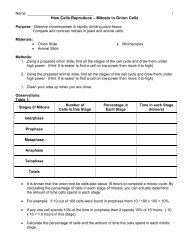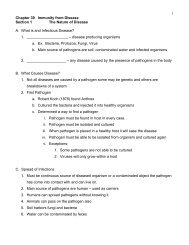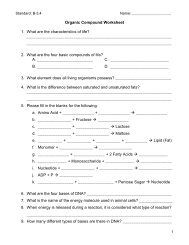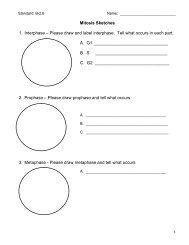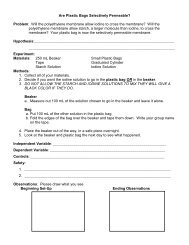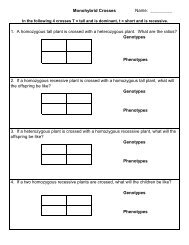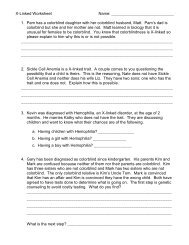Create successful ePaper yourself
Turn your PDF publications into a flip-book with our unique Google optimized e-Paper software.
1<br />
<strong>Unit</strong> 2 – <strong>Atomic</strong> <strong>Structure</strong><br />
Section 1 – Standards and Vocabulary<br />
A. Standards<br />
PS-2.1 Compare the subatomic particles (protons, neutrons, electrons) of an atom with regard to<br />
mass, location, and charge, and explain how these particles affect the properties of an atom<br />
(including identity, mass, volume, and reactivity).<br />
PS-2.2 Illustrate the fact that the atoms of elements exist as stable or unstable isotopes.<br />
PS-2.3 Explain the trends of the periodic table based on the elements’ valence electrons and atomic<br />
numbers.<br />
PS-2.4 Use the atomic number and the mass number to calculate the number of protons, neutrons,<br />
and/or electrons for a given isotope of an element.<br />
PS-2.5 Predict the charge that a representative element will acquire according to the arrangement of<br />
electrons in its outer energy level.<br />
PS-2.6 Compare fission and fusion (including the basic processes and the fact that both fission and<br />
fusion convert a fraction of the mass of interacting particles into energy and release a great<br />
amount of energy).<br />
PS-2.7 Explain the consequences that the use of nuclear applications (including medical<br />
technologies, nuclear power plants, and nuclear weapons) can have.<br />
B. Vocabulary<br />
• <strong>Atomic</strong> Mass<br />
• <strong>Atomic</strong> Number<br />
• Chain Reaction<br />
• Chemical Reaction<br />
• Chemically Stable<br />
• Chemically Unstable<br />
• Compound<br />
• Critical Mass<br />
• Electron<br />
• Electron Cloud<br />
• Energy Level<br />
• Family<br />
• Group<br />
• Ion<br />
• Isotope<br />
• Mass Number<br />
• Metal<br />
• Metalloid<br />
• Neutron<br />
• Nonmetal<br />
• Nuclear Decay<br />
• Nuclear Fission<br />
• Nuclear Fusion<br />
• Nuclear Medicine<br />
• Nuclear Power<br />
Reactors<br />
• Nuclear Weapons<br />
• Nucleus<br />
• Period<br />
• Periodic Table<br />
• Proton<br />
• Radiation<br />
• Sub-<strong>Atomic</strong> Particle<br />
• Valence Electron<br />
C. Book Correlations<br />
• Chapter 18<br />
• Chapter 19<br />
• Chapter 22 (Section 1 only)
2<br />
<strong>Unit</strong> 2 – <strong>Atomic</strong> <strong>Structure</strong><br />
Section 2 – Atoms & Subatomic Particles<br />
A. Atoms<br />
1. Atoms are the building blocks of matter.<br />
2. Everything on Earth is made up of atoms.<br />
3. Atoms are the smallest particle that is still considered matter – meaning it has all the<br />
properties of matter.<br />
4. Atoms are made up of Subatomic particles<br />
a. _____________________<br />
b. _____________________<br />
c. _____________________<br />
5. Have an area called a nucleus and area called the electron cloud<br />
a. ______________ – contains the protons and neutrons<br />
1. Has a _____________ charge<br />
b. ______________ – contains the electrons<br />
1. Has a _____________ charge<br />
c. Nucleus and electron cloud area are attracted to one another because one is<br />
negative and the other is positive.<br />
B. Subatomic Particles<br />
1. ____________________<br />
a. Mass = ______________<br />
b. Charge = ________________<br />
c. Location = ________________________<br />
d. Electrons are what cause the atoms to combine with one another<br />
e. They are attracted to the nucleus, which is positive and why they do not fly away.<br />
f. Electrons determine the reactivity of the atom / element. They are given up or<br />
shared.
3<br />
2. Neutron - n o<br />
a. Mass = ____________________<br />
b. Charge = ___________________<br />
c. Location = ___________________<br />
d. Can be as many neutrons or as few as the atom desires, they have no charge,<br />
only mass.<br />
3. Proton – p +<br />
a. Mass = _______________<br />
b. Charge = ________________<br />
c. Location = __________________<br />
d. Proton number determines the identity of the atom<br />
e. All elements that are the same, have the same number of protons<br />
Sub-<strong>Atomic</strong> Particle Mass Charge Location<br />
Electron<br />
Neutron<br />
Proton<br />
C. Periodic Table<br />
• Where can you find one?<br />
o Page 8 of your agenda<br />
o On the back of your yellow equation sheet<br />
1. Contains all the information you need about an atom, you just have to know how to read<br />
the periodic table.<br />
2. Important Parts<br />
a. __________ – This is a capital letter or a Capital letter and lower case letter.<br />
1. H<br />
2. He<br />
3. O<br />
4. Cu<br />
5. Fe<br />
6. Sn<br />
b. ______________ – this is the whole number that is in an individual block<br />
1. Tells you how many protons there are in a stable atom.<br />
2. Tells you how many electrons there are in a stable atom<br />
3. Tells you the location on the periodic table (read like a book).<br />
c. ________________ – this is the decimal number that is in an individual block<br />
1. You round this number to the nearest whole number using math rounding<br />
rules.<br />
2. This will help you determine the number of neutrons that are in the element<br />
a. Mass Number – Number of Protons = Number of Neutrons
4<br />
3. Example:<br />
8<br />
O<br />
Oxygen<br />
16.008<br />
<strong>Atomic</strong> Number _______<br />
Symbol __________<br />
<strong>Atomic</strong> Mass ___________<br />
Protons ______<br />
Neutrons _______<br />
Electrons _______<br />
Element<br />
Wavelength of Spectral Lines (nm)<br />
Hydrogen 434, 486, 656<br />
Helium 447, 468, 501, 587, 668<br />
Mercury 405, 436, 546, 577, 579<br />
Sodium 589, 590<br />
Calcium 393, 397<br />
Iron 517,<br />
Neon 438-452, 585, 587, 588, 594-598, 603-693<br />
Oxygen 687
5<br />
<strong>Unit</strong> 2 – <strong>Atomic</strong> <strong>Structure</strong><br />
Section 3 – <strong>Structure</strong> of an Atom<br />
A. Nucleus<br />
1. The nucleus contains the neutrons and protons.<br />
2. The nucleus is incredibly small as compared to where you find the electrons.<br />
3. The protons and neutrons are between one another<br />
B. Orbitals<br />
1. This area is known as the electron cloud.<br />
2. The electron cloud has areas called orbitals in which the electrons move.<br />
3. There are a maximum of seven orbitals that range from very close to the nucleus to farther<br />
away.<br />
4. There is a maximum number of electrons that each orbital can hold.<br />
a. 1 st Energy Level – _________________________<br />
b. 2 nd Energy Level – _________________________<br />
c. 3 rd Energy Level – _________________________<br />
d. 4 th Energy Level – _________________________<br />
e. 5 th Energy Level – _________________________<br />
f. 6 th Energy Level – _________________________<br />
g. 7 th Energy Level – _________________________<br />
C. Bohr Model – the accepted model for the electrons<br />
__ p +<br />
__ n o
6<br />
<strong>Unit</strong> 2 – <strong>Atomic</strong> <strong>Structure</strong><br />
Section 4 – Isotopes and Ions<br />
A. Isotope<br />
1. Isotopes are atoms of the same element with a different number of neutrons.<br />
2. They are still neutral atoms because only the neutrons change and neutrons have a<br />
NEUTRAL charge.<br />
3. Only the mass changes because neutrons have a mass of 1.<br />
B. Radioactive Isotopes<br />
1. Atoms that have an incorrect ratio of neutrons to protons are radioactive, meaning they<br />
give off radiation.<br />
2. Radiation is the type of energy that is given off from a substance in the form of high<br />
energy particles released from the atom in question<br />
i. __________________– short range danger – not strong (2 protons & 2 neutrons)<br />
ii. _____________________– stronger than alpha but less the gamma (electrons)<br />
iii. ______________– most dangerous because it has the highest amount of energy<br />
3. All items have radiation that is given off due to Nuclear Decay<br />
i. Nuclear Decay occurs naturally and is the breakdown of the nucleus over time.<br />
ii. Humans use this knowledge to our benefit<br />
1. Nuclear Medicine<br />
Pros<br />
Cons<br />
2. Nuclear Weapons<br />
Pros<br />
Cons
7<br />
3. Nuclear Power Reactors<br />
Pros<br />
Cons<br />
C. Determining a Isotope:<br />
1. You have to compare it to the periodic table and see that it is different<br />
Electrons Neutrons Protons Mass<br />
OR<br />
2. You have to be told that you have a change in the mass number. There are two ways<br />
to do this<br />
i. Symbol – Mass Number<br />
Symbol Electrons Neutrons Protons Mass<br />
C-12 6 6 6 12<br />
C-13<br />
C-11<br />
16<br />
15<br />
14<br />
17<br />
18<br />
14
8<br />
ii. Mass Number (Symbol)<br />
<strong>Atomic</strong> Number<br />
Symbol Electrons Neutrons Protons Mass<br />
12 C<br />
6 6 6 6 12<br />
13 C<br />
6<br />
11 C<br />
6<br />
14<br />
D. Examples<br />
1. You have found an element that has a mass of 33 AMU and contains 22 neutrons.<br />
i. What is the number of protons in this element? _________________________<br />
ii. What is the number of electrons in this element? _________________________<br />
iii. What is the element? _________________________<br />
iv. Identify this element as an isotope, written correctly. _____________________<br />
2. A student brings you an element with the mass of 8 AMU and 3 neutrons.<br />
i. What is the number of protons in this element? _________________________<br />
ii. What is the number of electrons in this element? _________________________<br />
iii. What is the element? _________________________<br />
iv. Identify this element as an isotope, written correctly. _____________________<br />
3. Zn-57<br />
i. What is the number of electrons in this element? _________________________<br />
ii. What is the number of neutrons in this element? _________________________<br />
iii. What is the number of protons in this element? _________________________<br />
iv. What is the element? _________________________<br />
4. Fe-86<br />
i. What is the number of electrons in this element? _________________________<br />
ii. What is the number of neutrons in this element? _________________________<br />
iii. What is the number of protons in this element? _________________________<br />
iv. What is the element? _________________________<br />
5. 4 H<br />
1<br />
6. 27 Na<br />
11<br />
i. What is the number of electrons in this element? _________________________<br />
ii. What is the number of neutrons in this element? _________________________<br />
iii. What is the number of protons in this element? _________________________<br />
iv. What is the element? _________________________<br />
i. What is the number of electrons in this element? _________________________<br />
ii. What is the number of neutrons in this element? _________________________<br />
iii. What is the number of protons in this element? _________________________<br />
iv. What is the element? _________________________
9<br />
E. Ions<br />
1. Ions are elements that are charged either positively or negatively due to the gaining or<br />
losing of electrons.<br />
2. This occurs naturally and is very normal<br />
3. If an element gains an electron it is negatively charged.<br />
4. If an element loses an electron it is positively charged.<br />
Symbol Lose/ Gain Electrons Neutrons Protons Mass Notation<br />
Li<br />
Neither<br />
Li Loses 1e -<br />
Li Gains 7e -<br />
O<br />
Neither<br />
O Gains 2e -<br />
O Loses 6e -<br />
5. Examples:<br />
i. An atom of nitrogen gains 3 electrons.<br />
1. What is the number of electrons? _________________________<br />
2. What is the number of neutrons? _________________________<br />
3. What is the number of protons? _________________________<br />
4. Is this a positive or negative atom? _________________________<br />
5. What is the notation? _________________________<br />
ii. At atom of magnesium loses 2 electrons<br />
1. What is the number of electrons? _________________________<br />
2. What is the number of neutrons? _________________________<br />
3. What is the number of protons? _________________________<br />
4. Is this a positive or negative atom? _________________________<br />
5. What is the notation? _________________________
10<br />
<strong>Unit</strong> 2 – <strong>Atomic</strong> <strong>Structure</strong><br />
Section 5 – The Periodic Table<br />
A. Groups<br />
• Vertical Columns<br />
• All have the same number of valence electrons<br />
1. Group 1 – ___________________<br />
i. One valence electron<br />
ii. Very Reactive with other elements<br />
iii. Likes to give away 1 electron<br />
2. Group 2 – _________________________<br />
i. Two valence electrons<br />
ii. Also very reactive<br />
iii. Likes to give away 2 electrons<br />
3. Groups 3-12 – _________________________<br />
i. Most have 1 or 2 valence electrons<br />
ii. These are tricky; they can do different things a lot of times.<br />
4. _________________________<br />
i. These are pulled out from the transition metals and dropped below on the table to be<br />
sure there is room for all the elements.<br />
ii. They follow the same trends as transitional elements.<br />
iii. They are named Lanthanides because where the elements are pulled out is the<br />
element Lanthanum.<br />
5. ____________________________<br />
i. These are pulled out from the transition metals and dropped below on the table to be<br />
sure there is room for all the elements.<br />
ii. They follow the same trends as transitional elements.<br />
iii. They are named Lanthanides because where the elements are pulled out is the<br />
element Actinium.
11<br />
6. Group 13 – _________________________<br />
i. Three valence electrons<br />
ii. Likes to give away three electrons<br />
7. Group 14 – _________________________<br />
i. Four valence electrons<br />
ii. Likes to share electrons<br />
iii. Bonds with MANY things<br />
iv. Likes to gain, lose or share four electrons<br />
8. Group 15 – _________________________<br />
i. Five valence electrons<br />
ii. Likes to gain three electrons<br />
9. Group 16 – _________________________<br />
i. Six valence electrons<br />
ii. Likes to gain two electrons<br />
iii. Very reactive!!<br />
10. Group 17 – _________________________<br />
i. Seven valence electrons<br />
ii. Likes to gain one electron<br />
iii. Very reactive!!<br />
11. Group 18 – _________________________<br />
i. Eight Valence Electrons<br />
ii. These do not react with anything<br />
iii. Helium is the exception, it does not react but<br />
it only has two valence electrons<br />
B. _________________________<br />
1. These are the horizontal rows on the periodic table.<br />
2. There are seven horizontal rows<br />
3. Tells you how many electron orbital’s are being used<br />
C. Major Categories of Elements<br />
1. _________________________<br />
i. Good Conductors of electricity and heat<br />
ii. Have Luster (Shininess)<br />
iii. High Density<br />
iv. High Melting Point<br />
v. Ductile – pulled into wire form<br />
vi. Malleable – fold and bend<br />
2. _________________________<br />
i. Not good conductors of electricity and heat<br />
ii. Lack Luster<br />
iii. Low Density<br />
iv. Low Melting Point<br />
v. Not Ductile<br />
vi. Not Malleable
12<br />
3. ____________________ – have characteristics of metals and non-metals<br />
i. Solids<br />
ii. Shiny or Dull<br />
iii. Can conduct electricity and heat but not great conductors<br />
D. Periodic Trends<br />
1. ___________________________<br />
i. The number of valence electrons increases from left right in groups 1-3, and 13-<br />
18<br />
2. ___________________________<br />
i. The number of energy levels/orbital’s increase as the periods increase.<br />
ii. The period number tells you how many energy levels / orbital’s are used<br />
3. Questions?<br />
i. Which element has more valence electrons Ca or S? ____________________<br />
ii. Which element has more valence electrons Si or Al? ____________________<br />
iii. Which element has more valence electrons B or At? ____________________<br />
iv. Which element has more valence electrons F or P? ____________________<br />
v. Which element has less valence electrons Cs or Te? ____________________<br />
vi. Which element has more energy levels Se or Po? ____________________<br />
vii. Which element has more energy levels Ra or S? ____________________
13<br />
<strong>Unit</strong> 2 – <strong>Atomic</strong> <strong>Structure</strong><br />
Section 6 – Nuclear Fission & Fusion<br />
A. _____________________<br />
1. Nuclear fission occurs when a heavy nucleus splits into two or more parts.<br />
2. There is a change in the number of protons and neutrons<br />
3. This is done by using a particle accelerator to bombard particles into atoms to make it split<br />
into two.<br />
4. Examples:<br />
i. ____________________<br />
ii. ____________________<br />
iii. ____________________<br />
B. _____________________________<br />
1. Nuclear fusion occurs when you combine two atom’s nuclei together to create a third type<br />
of nucleus.<br />
2. There is a change in the number of protons and neutrons<br />
3. This is done by using a particle accelerator to bombard particles into atoms to make it fuse<br />
the atoms into one.<br />
4. Example:<br />
i. ____________________<br />
ii. ____________________<br />
iii. ____________________<br />
• Both types of reactions involve very high temperatures and a lot of water to cool the reaction<br />
afterwards. The waste water must be neutralized and some of the water waste cannot be<br />
returned to the earth right away.<br />
• The materials used during these reactions contain high amounts of radiation and must have<br />
special storage.<br />
• This special storage is usually not close to the reactor in case of a meltdown accident. It is<br />
carried away and stored in other places.<br />
C. Remember Pros and Cons<br />
1. Nuclear Medicine<br />
Pros<br />
• Destroy targeted cells to be destroyed, like<br />
cancer cells.<br />
• Mapping the pathway of isotopes in the body,<br />
such as in the digestive or circulatory system.<br />
Cons<br />
• Waste from these tests have to be stored for<br />
LONG periods of time until no longer active.<br />
• When you are destroying bad cells you are<br />
also destroying good cells, however,<br />
treatment has gotten better in the last 10<br />
years.
14<br />
2. Nuclear Weapons<br />
Pros<br />
• Some people believe that nuclear weapons<br />
are a deterrent to war since WWII.<br />
• Only need a small amount of fuel (U)<br />
3. Nuclear Power Reactors<br />
Pros<br />
• Energy from nuclear fission reaction heats<br />
water to steam to rotate turbine.<br />
• Lots of energy available.<br />
• No air pollution<br />
• Abundance of Fuel<br />
• Decreases dependence on fossil fuels for<br />
electricity.<br />
Cons<br />
• Specialized technology is required to create<br />
the weapons.<br />
• Only need amount of fuel so easier to<br />
smuggle and hide.<br />
• Destruction Potential<br />
• Contamination to environment<br />
• Waste<br />
• Leakage<br />
Cons<br />
• Specialized technology is required.<br />
• Thermal pollution in lakes and streams<br />
• Waste Storage<br />
• Leakage<br />
• Accidents (Chernobyl, Three Mile Island)<br />
D. Comparison of Chemical and Nuclear Reactions<br />
Chemical Reaction<br />
Nuclear Reaction<br />
What part of the atom is<br />
involved?<br />
How is the reaction started?<br />
What is the outcome of the<br />
reaction?<br />
How much energy is absorbed<br />
or released?<br />
What are some examples?



